Golden Retrievers were first developed in 19th-century Scotland as gundogs, prized for their gentle mouths and loyalty during hunting. Known for their intelligence and eagerness to please, they’re often chosen as therapy dogs, search-and-rescue heroes, and even Hollywood stars – Air Bud rings a bell? Ranked consistently in the top 5 most popular dog breeds worldwide, Goldens are the perfect mix of affection, smarts, and golden-hearted charm.

Golden Retriever Puppy: 45 Days to 6 Months
Nutrition and Grooming Guide For Golden Retriever Pups That Actually Makes Sense
Feeding Guide for Golden Retriever Puppy
Golden Retriever puppies grow fast—and they need the right fuel to power through all that play, tail-wagging, and teething. A balanced diet is non-negotiable here. We’re talking about the full package: protein, healthy fats, complex carbs, vitamins, and minerals—the whole shebang.
Here’s what the nutritional needs of a Golden Retriever puppy look like:
- Protein Power: Think chicken, lamb, fish, or turkey—these high-quality animal proteins are key for muscle development.
- Fats for Brains (and That Gorgeous Coat): Omega-3 and omega-6 fatty acids help with brain development and give that silky Golden coat its shine.
- Carbs that Count: Complex carbs like brown rice, oats, and sweet potatoes give your pup the energy to chase butterflies—and their own tail.
- Vitamins & Minerals: Calcium and phosphorus for growing bones. Vitamins A, D, and E for a strong immune system and healthy skin.
Food Options That Work:
- Commercial Puppy Kibble: Choose one that’s specifically formulated for large breed puppies. Look for trusted names like Royal Canin, or Farmina N&D.
- Wet Food: Great for picky eaters and hydration, but always double-check that it meets all growth requirements.
- Home-Cooked? Yes, But Carefully: If you’re going the homemade route, always consult your vet. A mix of cooked lean meat, veggies like pumpkin and spinach, and whole grains works—but proportions are key.
How Often Should You Feed a Golden Retriever Puppy?
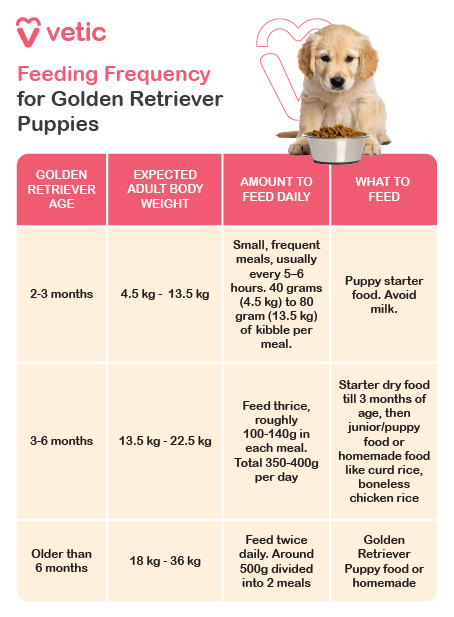
Let’s break it down:
- 8 to 12 Weeks: 4 small meals a day. They’re tiny, hungry, and always exploring.
- 12 to 24 Weeks: Reduce to 3 meals a day.
- 6 Months and Up: Transition to 2 meals a day.
Stick to a feeding schedule—same times every day. And avoid feeding right before bed. Nobody likes midnight tummy trouble.
Grooming Needs of Golden Retriever Puppy
Let’s not sugarcoat it—Golden Retriever puppies shed, they splash through mud, and they love to roll in things you can’t even identify. So yes, grooming needs of a Golden Retriever puppy are real. But hey, with a little routine, you’ve got this.
Coat Care:
- Brushing: That plush, flowing coat needs brushing 3–4 times a week. Use a slicker brush or a pin brush to keep shedding under control and mats away.
- Bathing: Once every 4–6 weeks or whenever they decide to dive into something questionable. Always use a gentle puppy shampoo.
- Ear Cleaning: Floppy ears can trap moisture. Clean them once a week to prevent infections.
- Nail Trimming: Check every 3–4 weeks. If you hear clicking on the floor, it’s time for a trim.
Dental Care:
Start early with a dog-friendly toothbrush and toothpaste. Brushing 2–3 times a week will help avoid future dental drama – and yes, bad breath too.
Golden Retriever Puppy: Complete Healthcare Guide
Preventive Care and Vaccination Schedule
Vaccinations: What Your Golden Needs and When
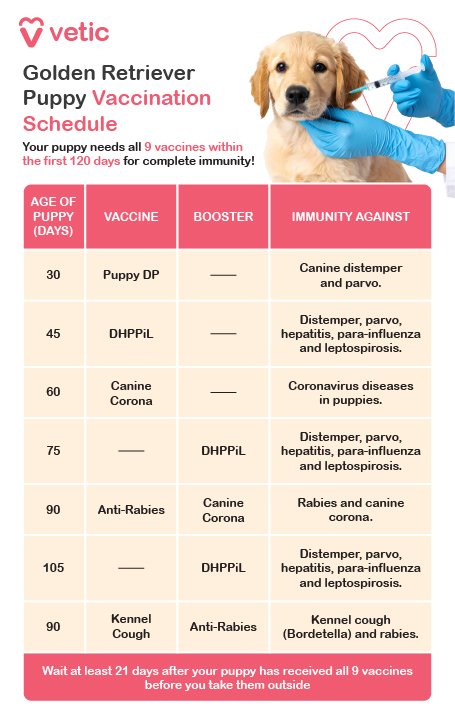
Golden Retriever puppies need a structured vaccination schedule to build immunity and stay protected from serious diseases they’re naturally vulnerable to. Here’s how the timeline usually goes:
- 6–8 Weeks: Time for the first round—Distemper and Parvovirus.
- 10–12 Weeks: Follow-up shots for Distemper, Parvovirus, Leptospirosis, Hepatitis, and Parainfluenza. Your vet might also administer the Rabies vaccine, depending on local guidelines.
- 14–16 Weeks: This is your puppy’s final core booster round. If Rabies wasn’t given earlier, it’ll be done now.
- 6 Months: Based on your puppy’s lifestyle (dog parks, boarding, travel), your vet may suggest additional protection with Kennel Cough and Canine Corona.
Stick to the schedule and follow your vet’s recommendations—it’s the best way to build lifelong protection.
Parasite Control: Don’t Let the Creepy-Crawlies Win
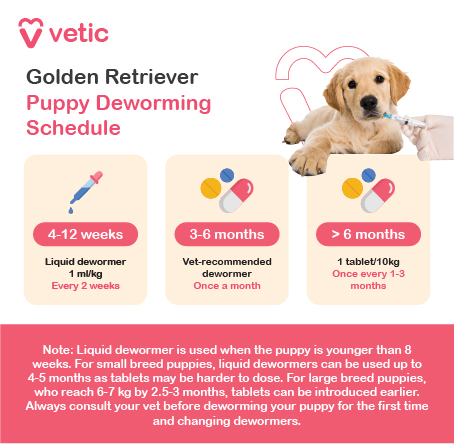
Golden Retrievers have a thick double coat that’s as beautiful as it is inviting to fleas and ticks. So, parasite protection isn’t optional—it’s essential.
- Flea and Tick Prevention: Begin vet-approved topical or oral treatments at 8 weeks. Regular grooming helps spot issues early.
- Heartworm Prevention: Golden Retrievers are sensitive to mosquito-borne diseases like heartworm. Start monthly preventives by 12 weeks—especially if you live in a warm, humid area.
Routine Vet Visits: Your Puppy’s Check-In Plan
From the day you bring your puppy home until about 16 weeks of age, make sure you’re seeing your vet every 3–4 weeks. These checkups keep your pup’s health on track with timely vaccinations, growth monitoring, nutrition tips, and behaviour guidance. It’s not just about shots—it’s about setting the right foundation.
Health Risks in Golden Retriever Puppies: Know What to Watch For
Golden Retrievers are one of the most loved breeds—and with good reason. But they also come with a few health quirks. The key is knowing what to look for so you can act early.
Here’s what to keep on your radar:
- Hip and Elbow Dysplasia: Common in Goldens and linked to genetics. Watch out for stiffness, limping, or that cute-but-worrisome bunny-hop walk, especially after rest or play.
- Obesity: These pups are enthusiastic eaters. Overfeeding can lead to joint stress and heart issues. Follow a feeding guide for Golden Retriever puppies and stick to proper portion sizes.
- Ear Infections: Floppy ears and a love of water? A recipe for trapped moisture. Clean their ears weekly and stay alert for signs of ear infections like odour, redness, or head-shaking.
- Skin Allergies: Goldens are prone to atopic dermatitis and food sensitivities. If you notice constant licking, scratching, or red patches, it’s time to speak to your vet.
- Subvalvular Aortic Stenosis (SAS): This is a congenital heart issue seen in the breed. Lethargy, fainting spells, or heavy breathing should never be ignored. (Ontiveros & Stern, 21)
Signs You Should Never Ignore
Puppies are energetic, messy, and unpredictable. But if you spot any of these red flags, it’s best to call your vet:
- Lethargy or tiredness that doesn’t go away with rest
- Repeated vomiting or diarrhoea
- Laboured breathing, coughing, or wheezing
- Persistent scratching, licking, or discomfort
- Sudden change in appetite or behaviour
Golden Retriever puppies are full of life and joy, and keeping them healthy starts with being proactive.
Golden Retriever Puppy: Activities, Exercise, and Training Guide
Physical Activities: Let That Puppy Energy Out (the Right Way)

Golden Retriever puppies are playful bundles of joy, but they’re still developing. So while they need plenty of movement, it’s important not to overdo it.
- Playtime All Day (Well, Almost): Short and fun sessions are best. Think fetch with soft toys, tug-of-war, or even a little hide-and-seek around the house. They love games that involve you.
- Short Walks: Start with 10–15 minute walks, 2–3 times a day. Increase the duration gradually, but avoid stairs, long hikes, or any high-impact activity until your vet gives the all-clear.
- Swimming (Goldens Love It!): Like Labradors, Golden Retrievers are natural water lovers. Once your vet approves, gentle swimming is a perfect low-impact workout.
Training: Start Early, Stay Positive
Training a Golden Retriever puppy is a joy—they’re smart and people-oriented, which means they pick up cues fast (especially when treats are involved).
- House Training: Use crate training and take your pup out regularly, especially after meals, naps, or playtime. Consistency is everything here.
- Basic Commands: Start with the basics—sit, stay, come, down, and heel. Use positive reinforcement like tiny treats, praise, and happy voice cues.
- Socialisation: Introduce your Golden to new people, pets, sounds, surfaces, and spaces. Early socialisation builds confidence and prevents fear-based behaviours later on.
Mental Stimulation: Keep That Brain Busy
Golden Retrievers aren’t just pretty faces—they’re smart cookies. And a bored Golden puppy will find something to do (like un-stuffing your sofa). Prevent that with:
- Puzzle toys and interactive feeders
- Hide-and-seek games
- Basic agility tasks (like crawling under a chair or finding a hidden toy)
This keeps their minds sharp and tires them out in the best way.
Behaviour Problems and Real-Life Fixes
Even the sweetest puppies come with a few quirks. Here’s what to expect—and how to deal with it like a pro:
Common Behaviour Issues in Golden Retriever Puppies:
- Chewing: Teething is real—and Goldens explore the world with their mouths. Offer a variety of safe chew toys and rotate them to keep things exciting.
- Jumping: That “jump-and-greet” move is cute when they’re tiny… not so much when they’re 30+ kg. Teach a “sit to say hi” routine from day one.
- Barking: Golden pups can become vocal if they’re bored or frustrated. Identify what sets it off and redirect the energy into training or play.
Your Go-To Behaviour Training Strategies:
- Redirection: If your pup’s chewing the sofa leg, calmly offer a toy instead—and praise like crazy when they take it.
- Positive Reinforcement: Reward behaviours you want to see—whether that’s sitting calmly or going potty outside.
- Consistency is Key: Everyone in the house should use the same commands, same timing, and same rules. Goldens are sensitive, and mixed signals confuse them.
Separation Anxiety: Goldens Feel Everything
Golden Retriever puppies form deep bonds and don’t love being left alone. That said, learning independence is important.
- Start with short periods of alone time, even if you’re just in another room.
- Leave behind a food puzzle toy or a shirt with your scent.
- Gradually extend the time apart so your puppy learns it’s okay to be alone—and that you always come back.
With patience, positive energy, and a bit of structure, your Golden Retriever puppy will grow into a polite, confident, and absolutely lovable companion.
Junior Golden Retriever: 6 Months to 18 Months
Golden Retriever Adolescent: Comprehensive Nutrition & Grooming Guide
Golden Retriever adolescence (typically 6 to 18 months) is a whirlwind of lanky legs, playful zoomies, and growing confidence. Behind all that energy, their bodies are undergoing serious development—and your feeding and grooming routines play a huge role in shaping them into healthy, happy adults.
Nutrition for Adolescent Golden Retriever Puppies
Golden Retriever adolescents need just the right balance of nutrients to fuel growth without tipping into obesity—something the breed is naturally prone to. That’s why a well-planned feeding guide for adolescent Golden Retriever dogs is so important.
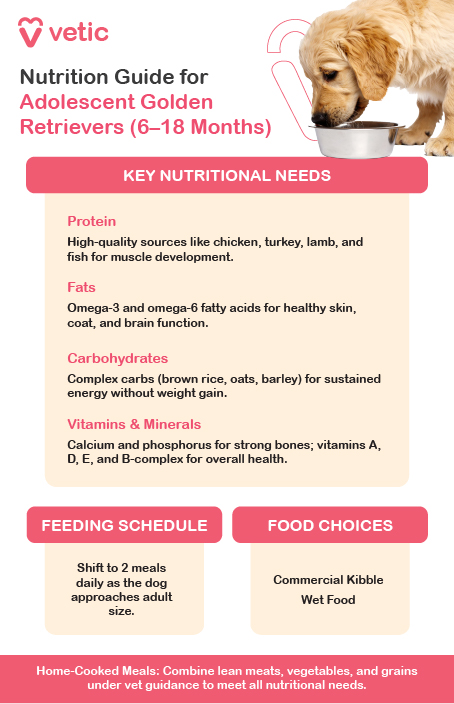
Nutritional Needs: What to Focus On
- Protein Power: Keep the focus on high-quality animal proteins like chicken, turkey, lamb, and fish to help build lean muscle and support joint development.
- Fats: Healthy fats, especially omega-3 and omega-6 fatty acids, keep their coats shiny, skin moisturised, and brains sharp as ever.
- Complex Carbs: Think brown rice, oats, and barley—these give sustained energy without spiking weight.
- Vitamins & Minerals: Calcium and phosphorus are essential for strong bones, while vitamins A, D, E, and B-complex keep immunity and metabolism on track.
Food Options: What Should Go in the Bowl?
- Commercial Kibble: Opt for large-breed adolescent or junior formulas from trusted brands like Royal Canin, Orijen, or N&D—they’re tailored to Golden-specific growth needs.
- Wet Food: Works well as a topper for variety and hydration. Just make sure it’s nutritionally complete.
- Home-Cooked Meals: Love cooking for your pup? That’s amazing—but do it right. Include lean meats, steamed veggies, and whole grains, and consult your vet to fill in any nutritional gaps.
Feeding Frequency and Timing
- 6 to 12 Months: Serve 2–3 meals a day, based on your pup’s energy level and weight.
- 12 to 18 Months: Shift to 2 meals per day as your Golden edges closer to adulthood.
Stick to a consistent schedule and use measuring cups for every meal. Avoid late-night feeding—it can lead to bloating or digestive discomfort.
Grooming Needs of a Golden Retriever Adolescent
That iconic Golden coat? Beautiful, yes—but it comes with grooming responsibility! This stage brings increased shedding and a need for regular upkeep.

Coat Care: Stay Ahead of the Shed
- Brushing: Brush 3–4 times a week using a slicker brush or de-shedding tool. It reduces mats, manages hair all over your home, and strengthens your bond with your pup.
- Bathing: Bathe your Golden every 2–3 months (or as needed) with a mild, dog-safe shampoo. Be careful not to overdo it—it can strip away natural oils.
- Ear Cleaning: Weekly ear cleaning is a must. Golden Retrievers’ floppy ears trap moisture, especially if your pup loves water. Use a vet-recommended ear cleaner and watch for any odour or discharge.
- Nail Trimming: Aim to trim the nails every 3–4 weeks. If you hear clicking on the floor, it’s time.
Dental Care: Don’t Skip the Teeth
Dental hygiene isn’t just about fresh breath—it’s key to long-term health.
- Brush teeth 2–3 times a week with dog-specific toothpaste.
- Dental chews can be a great supplement, especially if brushing is still a work in progress.
Your Golden Retriever adolescent is at a stage where habits start to stick—so this is the perfect time to set a strong foundation with the right nutrition and grooming routine.
Golden Retriever Adolescent: Complete Healthcare Guide
As your Golden Retriever puppy transitions into adolescence (typically between 6 to 18 months), their body, behaviour, and healthcare needs start to shift. This stage lays the groundwork for their long-term health—so let’s make sure they’re on the right track.
Preventive Care and Vaccination Schedule
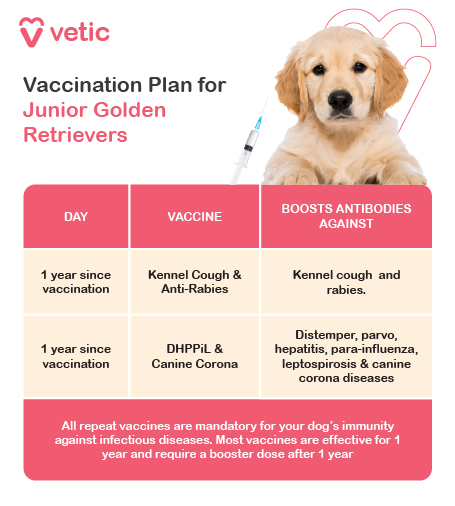
Vaccinations: Stay Up to Date
By the time your Golden Retriever hits adolescence, the primary vaccination schedule should be complete. But don’t skip the boosters!
- 12 Months: Time for booster shots of core vaccines—DHPPiL, and Rabies. Your vet will guide you based on your pup’s previous schedule.
- Optional Vaccines: Depending on where you live and your pup’s lifestyle (dog parks, swimming, travel), your vet may recommend additional protection against Kennel Cough, or Canine Influenza.
Parasite Control: Keep the Bugs Away
- Flea & Tick Prevention: Golden Retrievers have a thick double coat that offers warmth and perfect hiding spots for pests. Stay consistent with monthly preventives recommended by your vet.
- Heartworm Prevention: Continue with monthly heartworm medication—especially important if you’re in a mosquito-heavy region.
Regular Vet Check-Ups
Your Golden should see the vet every 6 months during this phase. These visits aren’t just about vaccines—they help track growth, joint development, and any behavioural or nutritional shifts. If something feels “off” to you, trust your gut and bring it up.
Health Risks and What to Watch Out For
Golden Retrievers are stunning, smart, and sweet—but they do have a few breed-specific health risks you need to stay ahead of.
Common Health Risks in Adolescents
- Joint Problems: Growth spurts can strain hips and elbows. Be on the lookout for limping, stiffness, or reluctance to play or climb stairs.
- Obesity: Goldens love food. And treats. And crumbs. Keep an eye on portion control and weight gain—it directly affects their joint health.
- Ear Infections: With those floppy ears and a passion for water, ear infections are a recurring concern. Clean the ears weekly and dry them well after baths or swims.
- Gastrointestinal Issues: Adolescents can get into mischief—eating odd things or reacting to sudden food changes. Monitor for bloating, vomiting, or loose stools.
Signs to Watch For
Call your vet if you notice:
- Sudden weight gain or noticeable weight loss
- Low energy or disinterest in play
- Persistent scratching, especially around ears
- Change in appetite or thirst
- Any weird, “this-isn’t-my-dog” behaviour
Golden Retrievers are such heart-stealers at this age—clumsy, goofy, and learning every day.
Golden Retriever Junior: Training and Behaviour
Adolescence in Golden Retrievers is where the fun—and the challenges—really begin. Around this time, your once tiny furball turns into a lanky, energetic, and slightly rebellious teenager. But with the right mix of physical exercise, mental stimulation, and consistent training, your Golden Retriever junior can grow into a well-mannered, confident adult.
Activities, Exercise, and Training
Physical Activities: Channel That Golden Energy
Golden Retrievers are playful and active, and their adolescent phase is packed with energy. Structured exercise is your best friend here.
- Daily Walks: Aim for 30–60 minutes per walk, once or twice a day. These walks are great for bonding and burning off extra energy.
Fetch and Running: Goldens love to retrieve (it’s in the name!). Short games of fetch are fantastic for both exercise and mental engagement. Just avoid high-impact jumping to protect growing joints. - Swimming: Golden Retrievers are natural water lovers. Swimming is an ideal low-impact activity that builds muscle and keeps them cool.
Training: Keep It Firm, Fun, and Frequent
Your Golden Retriever junior is smart—but sometimes a little too smart. Adolescence is when testing boundaries becomes a hobby. So, training has to evolve.
- Advanced Obedience: Start with longer “stays,” off-leash recall, and leash walking in busier environments. Goldens love to please—make it rewarding.
- Impulse Control: Practice exercises like “wait” before meals or “stay” at doorways to build patience and discipline.
- Socialisation: Continue to expose them to new people, pets, and surroundings. Positive exposure now prevents reactivity later.
Mental Stimulation: A Must for a Smart Pup
Golden Retrievers are bright and curious—and if they’re bored, you’ll know.
- Use puzzle toys, scent games, or hide treats for a sniffing challenge.
- Rotate their toys weekly to keep things fresh.
- Teach new tricks just for fun—yes, even “high five” counts!
Behaviour Problems and Solutions
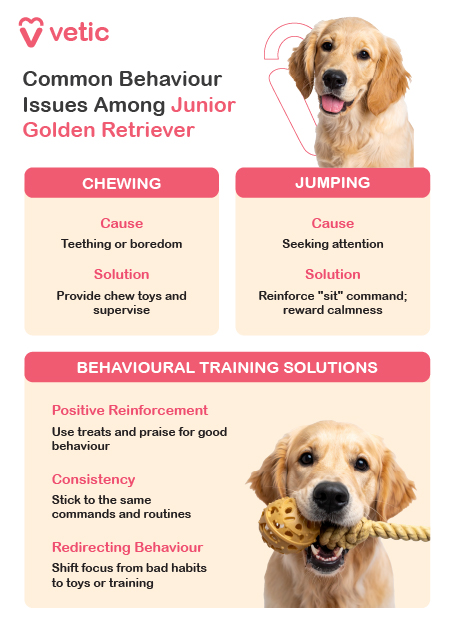
Common Behaviour Issues
- Chewing: Teething may be over, but boredom chewing is common. Provide safe chew toys and monitor their environment.
- Jumping: Adolescent Goldens often jump to show excitement. Teach a solid “sit to greet” habit and reward calm behaviour.
- Mouthing or Play-Biting: Gently correct this with redirection to a toy or chew, and use a firm “no” or disengage if needed.
Training Strategies That Work
- Positive Reinforcement: Praise, treats, play—whatever your Golden loves most. Use it to reinforce desired behaviours consistently. (Castro & Araujo, 2021)
- Consistency is Key: Everyone in the family should use the same commands and rules to avoid confusing your pup.
- Redirection: Redirect unwanted behaviours like barking, chewing, or pulling into more appropriate actions—like sitting, fetching a toy, or focusing on you.
Separation Anxiety: A Real Thing for Social Goldens
Golden Retrievers thrive on companionship. Some may become anxious when left alone. Help them cope by:
- Leaving interactive toys or chew treats when you step out
- Creating a cosy, safe space they enjoy
- Practicing short departures and gradually increasing time away.
Golden Retriever adolescents may test your patience at times—but with the right mix of exercise, structure, and love.
Golden Retriever Adult: 18 Months to 7 Years
Golden Retriever Adult: Comprehensive Nutrition Guide
Golden Retrievers are friendly, active, and always ready for a snack—but as they move into adulthood (roughly 18 months to 7 years), their nutritional needs change from growing up to staying fit, healthy, and happy. The goal? Maintain lean muscle, support joint health, and avoid unnecessary weight gain.
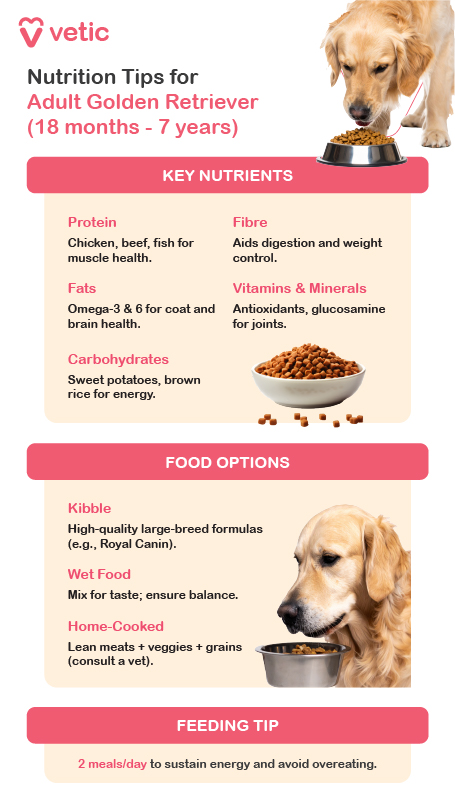
Nutritional Needs for Adult Golden Retrievers
Golden Retrievers are prone to obesity and joint problems, so their adult diet should focus on balance—not just calories.
- Protein: Stick to high-quality sources like chicken, fish, lamb, or turkey to maintain strong muscles without extra fat.
- Healthy Fats: Omega-3 and omega-6 fatty acids (found in fish oil and flaxseed) are great for your Golden’s glossy coat, brain function, and skin health.
- Complex Carbs: Choose carbs like sweet potatoes, oats, and brown rice to keep your dog energised throughout the day—without spikes or crashes.
- Fibre: A little extra fibre helps support digestion and keeps your Golden feeling full, which is key for weight management.
- Vitamins & Minerals: Keep an eye out for antioxidants (like vitamins C & E) and joint-friendly nutrients like glucosamine and chondroitin, especially if your dog loves running and jumping.
Food Options
There are several ways to feed your adult Golden Retriever—pick what works best for your lifestyle and their preferences.
- Commercial Kibble: Choose high-quality large-breed adult formulas from brands like Royal Canin, Acana, or Farmina. Look for formulas with added joint support.
- Wet Food: Wet food adds moisture and variety but must be nutritionally complete if used on its own.
- Home-Cooked Meals: Prefer cooking at home? Combine lean meats, veggies, and whole grains—but always talk to your vet to ensure a balanced diet.
Feeding Frequency and Routine
- 18 Months and Up: Feed two meals a day to help stabilise energy levels and avoid overeating.
- Keep a fixed feeding schedule—consistency helps with digestion and behaviour.
- Avoid feeding right before or right after exercise to reduce the risk of bloat—a serious condition in deep-chested breeds like Golden Retrievers.
A well-fed Golden Retriever is more than just a happy face and wagging tail—it’s a dog that’s healthy from the inside out.
Labrador Retriever Adult: Complete Healthcare Guide
Preventive Care and Vaccination Schedule
Vaccinations for Adult Golden Breed:
By adulthood, your Labrador should have received all core vaccinations. However, booster shots and optional vaccines may still be necessary.
Annual Boosters: Depending on your vet’s advice, your Labrador may require annual boosters for core vaccines (DHPPiL and Rabies).
Optional Vaccines: Based on your location and lifestyle, consider vaccines for Kennel Cough, and Canine Corona.
Parasite Control:
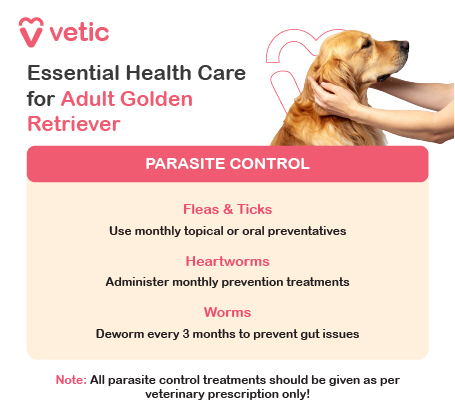
Flea and Tick Prevention: Use monthly topical or oral preventatives to protect against fleas and ticks.
Heartworm Prevention: Continue monthly heartworm prevention treatments.
Regular Vet Check-ups:
Schedule annual veterinary visits to monitor your Labrador’s overall health, weight, and dental condition. Regular blood tests may be recommended to catch any early signs of health issues.
Grooming Necessities and Frequency
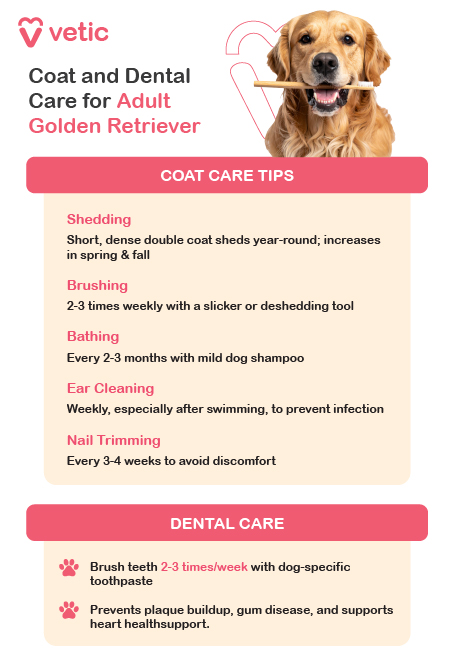
Coat Care:
Labrador Retrievers have a short, dense double coat that sheds year-round, with increased shedding in the spring and fall.
Brushing: Brush the coat 2-3 times a week with a slicker brush for deshedding tools to manage shedding and keep the coat healthy.
Bathing: Bathe your Labrador every 2-3 months or as needed. Use a mild dog shampoo that maintains the coat’s natural oils.
Ear Cleaning: Labradors are prone to ear infections, so clean the ears weekly with a vet-recommended cleaner, especially after swimming.
Nail Trimming: Trim the nails every 3-4 weeks to prevent overgrowth and discomfort.
Dental Care:
Brush your Labrador’s teeth 2-3 times a week using dog-specific toothpaste to prevent plaque buildup and gum disease.
Visit the veterinarian at least once a year for professional cleaning of your dog’s teeth.
Health Risks and What to Watch Out For
Common Health Risks:
Hip and Elbow Dysplasia: Monitor for signs of joint discomfort, such as limping, stiffness, or reluctance to move. Early intervention can help manage these conditions.
Obesity: Labradors are prone to weight gain, which can exacerbate joint issues and lead to other health problems. Monitor your dog’s weight and adjust diet and exercise accordingly.
Ear Infections: Due to their love for water, Labradors are susceptible to ear infections. Regular cleaning and monitoring are essential.
Gastrointestinal Issues: Be cautious with your Labrador’s diet and avoid feeding table scraps to prevent digestive upset or more serious issues like pancreatitis.
Hypothyroidism: Labradors are at risk for hypothyroidism, which can lead to weight gain, lethargy, and skin issues. Regular vet visits can help detect and manage this condition.
Signs to Watch For:
- Decreased activity levels or reluctance to exercise
- Weight gain despite consistent feeding and exercise
- Persistent ear scratching, head shaking, or foul odour from the ears
- Vomiting, diarrhoea, or changes in appetite
- Behavioural changes such as increased aggression or anxiety
If any of these symptoms arise, consult your veterinarian for advice and potential treatment.
Labrador Retriever Adult: Activities and Behavioural Training
Activities, Exercise, and Training
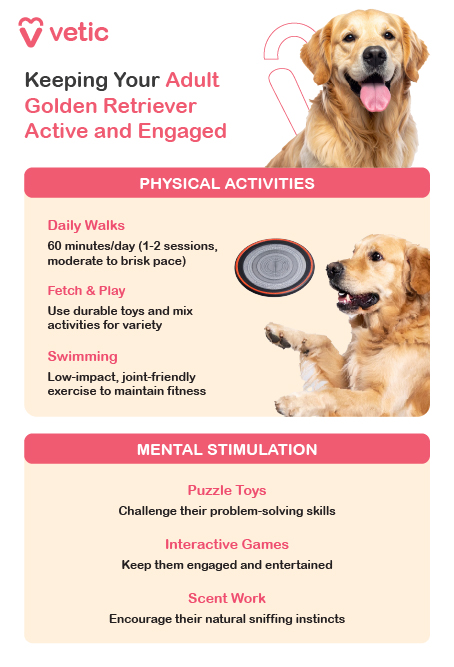
Physical Activities:
Adult Labradors are highly active and require regular exercise to maintain their physical and mental health.
Daily Walks: Provide at least 60 minutes of moderate to brisk walking daily, divided into 1-2 sessions.
Fetch and Play: Labradors love fetch, and it’s an excellent way to burn off energy. Use durable toys and vary the activities to keep them engaged.
Swimming: Continue to encourage swimming, which is a low-impact exercise that’s gentle on the joints while being highly effective in maintaining fitness.
Training:
Training remains essential in adulthood to reinforce good behaviour and provide mental stimulation.
Advanced Commands: Continue building on basic obedience with advanced commands like “wait,” “leave it,” and off-leash recall.
Agility and Obedience Training: Engage in structured activities like agility courses or advanced obedience classes to challenge their mind and body.
Socialisation: Regularly expose your Labrador to new environments and situations to maintain their confidence and prevent anxiety.
Mental Stimulation:
Provide puzzle toys, interactive games, and scent work to keep your Labrador mentally engaged, reducing the risk of boredom-related behaviours.
Behaviour Problems and Solutions
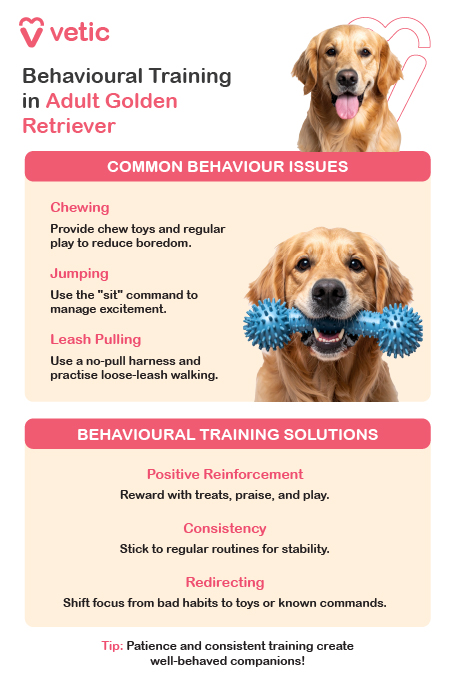
Common Behaviour Issues:
Chewing: Adult Labradors may continue to chew out of boredom or anxiety. Provide appropriate chew toys and engage in regular play to alleviate this behaviour.
Jumping on People: Labradors are friendly and may jump up on people out of excitement. Reinforce the “sit” command before allowing attention.
Pulling on the Leash: As strong adults, Labradors may pull on the leash during walks. Use a no-pull harness and continue practising loose-leash walking.
Behavioral Training Solutions:
Positive Reinforcement: Continue using treats, praise, and play to reinforce good behaviour. Avoid punishment, as it can lead to fear and anxiety.
Consistency: Maintain a consistent routine for feeding, exercise, and training to provide structure and reduce stress.
Redirecting: If your Labrador exhibits unwanted behaviour, redirect their attention to a toy or command they know.
Managing Separation Anxiety:
Labradors are social dogs and can develop separation anxiety if left alone for long periods. Gradually increase the time spent apart, and provide enrichment toys to keep them occupied.
Golden Retriever Senior: 7 years and Older
Golden Retriever Senior: Comprehensive Nutrition Guide
From around 7 years and older, Golden Retrievers begin entering their senior years. While they often stay playful and loving, their nutritional needs change with age. The right diet can help manage weight, support joints, and maintain overall health so your golden oldie continues to shine.
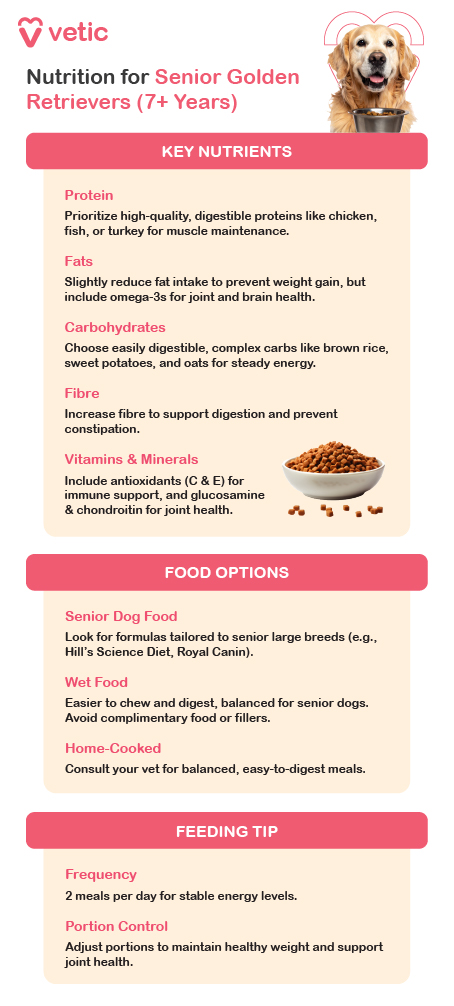
Nutritional Needs for Senior Golden Retrievers
As Golden Retrievers age, they become more prone to arthritis, heart issues, and cancer—so a nutrient-rich, senior-appropriate diet is essential.
- Protein: Offer high-quality, easy-to-digest proteins like chicken, turkey, or fish to support muscle mass and immunity.
- Fats: Slightly reduce fat content to prevent weight gain but include omega-3 fatty acids (from fish oil or flaxseed) to support joints and brain function.
- Carbohydrates: Choose gentle complex carbs such as oats, brown rice, and sweet potatoes that give sustained energy without upsetting digestion.
- Fibre: Increase fibre to promote digestive regularity—something many senior dogs struggle with.
- Vitamins & Minerals: Antioxidants (like vitamins C and E) help boost immunity. Glucosamine and chondroitin support aging joints, especially as Golden Retrievers are susceptible to hip dysplasia and arthritis.
Food Options for Senior Goldens
- Senior Dog Food: Pick a large-breed senior formula from trusted brands like Hill’s Science Diet, Royal Canin, or Orijen. These are designed to support joint health, digestion, and weight control.
- Wet Food: A great option if your dog is picky or has dental concerns. Just ensure it’s nutritionally complete for senior dogs.
- Home-Cooked Meals: If you’re cooking at home, focus on lean meats, soft-cooked veggies, and easy-to-digest grains. Always consult your vet to avoid nutritional gaps.
Feeding Frequency and Timing
- 7 Years and Up: Stick to 2 meals a day to help regulate metabolism and prevent blood sugar spikes.
- Measure food portions carefully, and adjust based on weight, energy levels, and activity.
- Avoid feeding right before or after long walks to reduce the risk of bloat and torsion, which Golden Retrievers are vulnerable to.
Grooming Necessities and Frequency

Senior Goldens might experience drier skin, more shedding, or a duller coat. Regular grooming not only keeps them clean but also helps spot health changes early.
- Brushing: Brush 2–3 times a week with a soft-bristle brush or grooming mitt. It removes loose fur, reduces shedding, and keeps the coat shiny.
Bathing: Bathe every 2–3 months, or more often if needed, using a moisturising or oatmeal-based dog shampoo to soothe older skin. - Ear Cleaning: Goldens are prone to ear infections, especially if they’re still occasional swimmers. Clean ears weekly to prevent buildup and infections.
- Nail Trimming: Trim every 3–4 weeks. Senior dogs move less, so their nails may not wear down naturally.
- Dental Care: Dental disease is common in senior dogs. Brush teeth 2–3 times per week, and use dental chews or vet-approved rinses if brushing becomes hard.
Tip: Schedule regular senior wellness check-ups with your vet. Catching problems early—whether it’s arthritis, dental disease, or heart conditions—makes a big difference in your dog’s quality of life.
Golden Retriever Senior: Complete Healthcare Guide
Senior Golden Retrievers, typically 7 years and older, need extra care and attention to age comfortably. With the right preventive care and close monitoring, your gentle companion can enjoy their golden years with grace and comfort.
Preventive Care and Vaccination Schedule
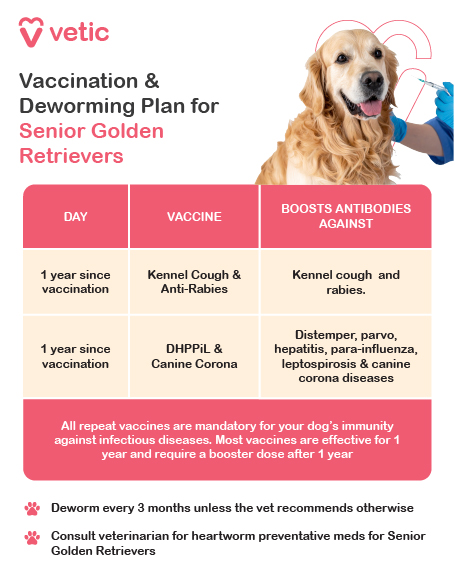
Vaccinations:
Golden Retrievers should continue receiving essential vaccines in their senior years. However, your vet may modify the vaccination plan depending on your dog’s overall health and lifestyle.
- Annual Boosters: Core vaccines like Rabies, and DHPPiL may still be needed annually or every three years—check with your vet for personalised guidance.
- Optional Vaccines: If your dog still frequents parks or grooming salons, Bordetella (kennel cough) and Corona vaccines may still be recommended.
Parasite Control:
Older dogs still need protection from parasites, especially if they spend time outdoors.
- Flea & Tick Prevention: Continue year-round flea and tick control. Opt for senior-friendly formulations if your Golden has sensitive skin.
- Heartworm Prevention: Monthly heartworm medication remains essential unless your vet advises otherwise.
Regular Vet Check-ups:
Senior Golden Retrievers benefit from bi-annual health checks. These help detect early signs of age-related illnesses, allowing for prompt treatment.
Your vet may recommend:
- Blood tests
- Urinalysis
- Thyroid panels
- X-rays for joints or internal organs (if needed)
Health Risks and What to Watch Out For
Golden Retrievers are prone to several age-related health conditions. Early detection can make a big difference.
Common Health Concerns:
- Arthritis and Joint Stiffness: Goldens are especially prone to hip dysplasia and arthritis. Watch for limping, stiffness, or hesitation to climb stairs.
- Obesity: Weight gain is common in less active seniors. Extra weight adds strain on joints and increases health risks.
- Hypothyroidism: This condition is more common in Golden Retrievers. Symptoms include sluggishness, skin infections, and unexplained weight gain.
- Heart Disease: Senior Goldens can develop heart issues. Look for signs like coughing, fatigue, or laboured breathing.
- Cancer: Sadly, Golden Retrievers are genetically predisposed to several types of cancer, including lymphoma and hemangiosarcoma. Regularly check for new lumps or changes in existing ones.
- Canine Cognitive Dysfunction (Doggie Dementia): Look for disorientation, pacing, changes in sleep patterns, or increased vocalisation or anxiety.
Signs That Need Vet Attention
- Difficulty getting up or moving after resting
- Sudden weight gain or loss
- Persistent coughing, breathing issues, or tiring easily
- Change in eating, drinking, or elimination habits
- New or changing lumps or bumps
- Confusion, wandering, or restlessness at night
If you notice any of the above, don’t wait. Schedule a vet visit for a full senior health assessment.
Labrador Retriever Senior: Activity and Behaviour Training

Activities, Exercise, and Training
Physical Activities: While senior Labradors may not have the same energy levels as their younger selves, regular exercise is still crucial to maintain mobility, manage weight, and promote mental well-being.
- Daily Walks: Continue with daily walks, but reduce the intensity and duration if your dog shows signs of fatigue. Aim for 20-30 minutes per session, twice a day.
- Swimming: Swimming remains an excellent low-impact exercise that is gentle on aging joints while keeping your dog active.
- Gentle Play: Engage in gentler play activities like fetch, but avoid high-impact exercises that could strain joints.
Training: Training during senior years helps keep your Labrador’s mind sharp and reinforces good behavior.
- Refresher Commands: Regularly practice basic obedience commands like “sit,” “stay,” and “come” to keep your dog mentally engaged.
- Adaptation Training: Adjust training to accommodate any sensory decline (like hearing or vision loss) by incorporating hand signals or touch commands.
Mental Stimulation:
Provide senior-friendly puzzle toys and scent games to stimulate your Labrador’s mind. Regular mental exercise can help delay cognitive decline and reduce anxiety.
Behavior Problems and Solutions
Common Behavior Issues:
- Separation Anxiety: Senior Labradors may develop or experience worsening separation anxiety due to cognitive decline or increased dependency. Provide a calm, secure environment and consider anti-anxiety treatments if needed.
- House Soiling: Older dogs may have accidents due to cognitive decline or health issues like incontinence. Increase potty breaks and consult your vet if the issue persists.
- Increased Vocalization: Cognitive decline can lead to increased barking or whining. Ensure your dog is comfortable and use gentle redirection or calming techniques to reduce stress.
Behavioral Training Solutions:
- Gentle Training: Use gentle reinforcement techniques to address any behavior issues. Avoid punishment, as it can increase anxiety and confusion.
- Routine: Maintain a consistent routine for feeding, exercise, and sleep to provide stability and reduce stress.
- Comfort and Security: Ensure your Labrador has a comfortable place to rest, free from drafts or noise. Consider using calming products like pheromone diffusers if your dog seems anxious.
Managing Cognitive Decline (Ehrenzweig & Hunter, 2023):
For Labradors showing signs of cognitive dysfunction, incorporate brain games, interactive toys, and regular mental stimulation to slow the progression. Your vet may recommend medications or supplements that support brain health.
What You Should Remember Before Adopting a Golden Retriever
Golden Retrievers are more than just beautiful—they’re emotionally intuitive, people-loving companions who thrive in affectionate, active homes. They do best with pet parents who enjoy outdoor fun, have time for training and cuddles, and want a true four-legged family member. Whether you’re a first-time dog parent or adding to a pack, a Golden’s loyalty, warmth, and ever-wagging tail make them an unforgettable part of your life. Simply put—they love hard and live happy.
References
Castro, A. C. V. d., & Araujo, A. (2021). Improving dog training methods: Efficacy and efficiency of reward and mixed training methods (S. Clegg, Ed.). PLOS One, 16(2), 9. https://journals.plos.org/plosone/article?id=10.1371/journal.pone.0247321#sec011. https://doi.org/10.1371/journal.pone.0247321
Ehrenzweig, J., & Hunter, R. P. (2023). Canine cognitive decline and Alzheimer disease: clinical insights to solve a shared one-health problem. Journal of the American Veterinary Medical Association (JAVMA), 261(11), 1597–1604. https://avmajournals.avma.org/view/journals/javma/261/11/javma.23.02.0095.pdf
Ontiveros, E. S., & Stern, J. A. (21, May). Genetics of canine subvalvular aortic stenosis (SAS). Canine Genet Epidemiol 8, 4 (2021)., 8(4), 8. https://rdcu.be/ep65c
